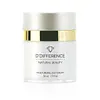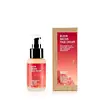What's inside
What's inside
 Key Ingredients
Key Ingredients

 Benefits
Benefits

 Concerns
Concerns

 Ingredients Side-by-side
Ingredients Side-by-side

Water
Skin ConditioningCarthamus Tinctorius Oleosomes
EmollientPrunus Amygdalus Dulcis Oil
Skin ConditioningHelianthus Annuus Seed Oil
EmollientSimmondsia Chinensis Seed Oil
EmollientVitis Vinifera Seed Oil
EmollientSodium Acrylate/Sodium Acryloyldimethyl Taurate Copolymer
Emulsion StabilisingSqualane
EmollientXylitylglucoside
HumectantNiacinamide
SmoothingOlive Oil Glycereth-8 Esters
EmollientAnhydroxylitol
HumectantAloe Barbadensis Leaf Juice
Skin ConditioningXylitol
HumectantSr-Spider Polypeptide-1
Skin ProtectingTocopherol
AntioxidantAscorbyl Palmitate
AntioxidantRetinyl Palmitate
Skin ConditioningCitrus Aurantium Bergamia Fruit Oil
MaskingGlycereth-2 Cocoate
EmulsifyingPhenoxyethanol
PreservativeDecylene Glycol
Skin ConditioningCaprylyl Glycol
EmollientSodium Benzoate
MaskingPotassium Sorbate
PreservativeParfum
MaskingWater, Carthamus Tinctorius Oleosomes, Prunus Amygdalus Dulcis Oil, Helianthus Annuus Seed Oil, Simmondsia Chinensis Seed Oil, Vitis Vinifera Seed Oil, Sodium Acrylate/Sodium Acryloyldimethyl Taurate Copolymer, Squalane, Xylitylglucoside, Niacinamide, Olive Oil Glycereth-8 Esters, Anhydroxylitol, Aloe Barbadensis Leaf Juice, Xylitol, Sr-Spider Polypeptide-1, Tocopherol, Ascorbyl Palmitate, Retinyl Palmitate, Citrus Aurantium Bergamia Fruit Oil, Glycereth-2 Cocoate, Phenoxyethanol, Decylene Glycol, Caprylyl Glycol, Sodium Benzoate, Potassium Sorbate, Parfum
Aloe Barbadensis Leaf Juice Powder
Skin ConditioningGlycerin
HumectantCoco-Caprylate/Caprate
EmollientPropanediol
SolventPrunus Amygdalus Dulcis Oil
Skin ConditioningWater
Skin ConditioningCetearyl Alcohol
EmollientGlyceryl Stearate
EmollientButyrospermum Parkii Butter
Skin ConditioningPotassium Palmitoyl Hydrolyzed Wheat Protein
CleansingSimmondsia Chinensis Seed Oil
EmollientCaprylic/Capric Triglyceride
MaskingCalanthe Discolor Extract
Skin ConditioningSodium Hyaluronate
HumectantBrassica Oleracea Italica Extract
AstringentHydrolyzed Rhodophyceae Extract
Helianthus Annuus Seed Oil
EmollientVaccinium Vitis-Idaea Fruit Extract
AntioxidantCitrus Grandis Peel Extract
AstringentLavandula Angustifolia Flower/Leaf/Stem Extract
MaskingPrunus Armeniaca Fruit Extract
Skin ConditioningPyrus Malus Fruit Extract
Skin ConditioningCitrus Aurantifolia Peel Extract
CleansingCucumis Melo Fruit Extract
Skin ConditioningMentha Piperita Leaf Extract
Skin ConditioningPrunus Amygdalus Dulcis Bud Extract
Skin ConditioningPrunus Persica Fruit Extract
AbrasiveVanilla Planifolia Fruit Extract
Skin ConditioningAstaxanthin
Skin ConditioningSalvia Sclarea Extract
AntiseborrhoeicSalicornia Herbacea Extract
Skin ConditioningCitrus Aurantium Dulcis Peel Extract
Emulsion StabilisingAgastache Mexicana Flower/Leaf/Stem Extract
Skin ConditioningCarthamus Tinctorius Seed Oil
MaskingGlycine Soja Oil
EmollientGlyceryl Caprylate
EmollientArginine
MaskingLevulinic Acid
PerfumingSclerotium Gum
Emulsion StabilisingLysolecithin
EmulsifyingSilica
AbrasiveSodium Levulinate
Skin ConditioningXanthan Gum
EmulsifyingPullulan
P-Anisic Acid
MaskingSodium Phytate
Beta-Sitosterol
Emulsion StabilisingCalcium Gluconate
HumectantCitric Acid
BufferingPotassium Sorbate
PreservativeGluconolactone
Skin ConditioningSqualene
EmollientTocopherol
AntioxidantSodium Benzoate
MaskingLimonene
PerfumingLinalool
PerfumingAloe Barbadensis Leaf Juice Powder, Glycerin, Coco-Caprylate/Caprate, Propanediol, Prunus Amygdalus Dulcis Oil, Water, Cetearyl Alcohol, Glyceryl Stearate, Butyrospermum Parkii Butter, Potassium Palmitoyl Hydrolyzed Wheat Protein, Simmondsia Chinensis Seed Oil, Caprylic/Capric Triglyceride, Calanthe Discolor Extract, Sodium Hyaluronate, Brassica Oleracea Italica Extract, Hydrolyzed Rhodophyceae Extract, Helianthus Annuus Seed Oil, Vaccinium Vitis-Idaea Fruit Extract, Citrus Grandis Peel Extract, Lavandula Angustifolia Flower/Leaf/Stem Extract, Prunus Armeniaca Fruit Extract, Pyrus Malus Fruit Extract, Citrus Aurantifolia Peel Extract, Cucumis Melo Fruit Extract, Mentha Piperita Leaf Extract, Prunus Amygdalus Dulcis Bud Extract, Prunus Persica Fruit Extract, Vanilla Planifolia Fruit Extract, Astaxanthin, Salvia Sclarea Extract, Salicornia Herbacea Extract, Citrus Aurantium Dulcis Peel Extract, Agastache Mexicana Flower/Leaf/Stem Extract, Carthamus Tinctorius Seed Oil, Glycine Soja Oil, Glyceryl Caprylate, Arginine, Levulinic Acid, Sclerotium Gum, Lysolecithin, Silica, Sodium Levulinate, Xanthan Gum, Pullulan, P-Anisic Acid, Sodium Phytate, Beta-Sitosterol, Calcium Gluconate, Citric Acid, Potassium Sorbate, Gluconolactone, Squalene, Tocopherol, Sodium Benzoate, Limonene, Linalool
Alternatives
Ingredients Explained
These ingredients are found in both products.
Ingredients higher up in an ingredient list are typically present in a larger amount.
Helianthus Annuus Seed Oil is the oil derived from the seeds of a Sunflower. Sunflower seed oil is non-fragrant. It is an emollient, meaning it helps to soften the skin.
Sunflower seed oil contains many fatty acids. The fatty acids found in sunflower seeds include (from highest amount to least): linoleic acid, myristic acid, palmitic acid, stearic acid, arachidic acid, oleic acid, and linolenic acid.
These fatty acids help the skin create ceramides. Ceramides play a role in repairing the skin barrier.
Helianthus Annuus Seed Oil helps moisturize the skin. This in turn helps the skin look more rejuvenated and smoother.
Sunflowers are rich in vitamin E.
Historians believe Indigenous cultures of North America domesticated sunflowers before corn. Thus they relied on sunflower oil for a variety of uses. One such use is moisturizing skin and hair.
Sunflower seed oil may not be fungal acne safe. We recommend speaking with a professional if you have any concerns.
Learn more about Helianthus Annuus Seed OilPotassium Sorbate is a preservative used to prevent yeast and mold in products. It is commonly found in both cosmetic and food products.
This ingredient comes from potassium salt derived from sorbic acid. Sorbic acid is a natural antibiotic and effective against fungus.
Both potassium sorbate and sorbic acid can be found in baked goods, cheeses, dried meats, dried fruit, ice cream, pickles, wine, yogurt, and more.
You'll often find this ingredient used with other preservatives.
Learn more about Potassium SorbatePrunus Amygdalus Dulcis Oil comes from the sweet almond, a tree native to Iran. This oil has no fragrance and is non-volatile.
Almonds contain healthy fats, vitamins, and minerals. It is a rich source of Vitamin E, a great antioxidant and skin conditioning ingredient. Sweet almond oil contains fatty acids such as linolenic acid and triglycerides.
The content of sweet almond oil makes it a great emollient; it can help soften and hydrate your skin. Emollients create a barrier over your skin to trap moisture in. Sweet almond oil has antioxidant properties.
Those with an almond allergy should be careful of this ingredient and speak with a professional about using it in your skincare.
This ingredient may not be fungal-acne safe.
Learn more about Prunus Amygdalus Dulcis OilThis oil comes from the seeds of the desert shrub called Jojoba. It is more commonly known as jojoba oil, a non-comedogenic oil.
Jojoba oil does not contain fragrance and has many fatty-acids, making it a great soothing ingredient.
It also contains Vitamin E, a great moisturizing ingredient. Vitamin E is also an antioxidant and protects your skin against oxidative damage.
This ingredient humectant properties, meaning it helps draw moisture from the air. This helps keep your skin hydrated.
While jojoba has antibacterial properties, it is only able to kill some strains of bacteria.
Studies also show it helps in wound healing. In fact, Indigenous cultures have used jojoba as a moisturizer and to help treat burns for centuries.
Fun fact: Jojoba oil similar to natural human skin sebum, so it has a great effect on dry skin. It is also promising with helping to regulate sebum production.
Due to its fatty acid content, Jojoba oil may not be fungal acne safe. We recommend speaking with a professional if you have any concerns.
Learn more about Simmondsia Chinensis Seed OilSodium Benzoate is a preservative. It's used in both cosmetic and food products to inhibit the growth of mold and bacteria. It is typically produced synthetically.
Both the US FDA and EU Health Committee have approved the use of sodium benzoate. In the US, levels of 0.1% (of the total product) are allowed.
Sodium benzoate works as a preservative by inhibiting the growth of bacteria inside of cells. It prevents the cell from fermenting a type of sugar using an enzyme called phosphofructokinase.
It is the salt of benzoic acid. Foods containing sodium benzoate include soda, salad dressings, condiments, fruit juices, wines, and snack foods.
Studies for using ascorbic acid and sodium benzoate in cosmetics are lacking, especially in skincare routines with multiple steps.
We always recommend speaking with a professional, such as a dermatologist, if you have any concerns.
Learn more about Sodium BenzoateTocopherol (also known as Vitamin E) is a common antioxidant used to help protect the skin from free-radicals and strengthen the skin barrier. It's also fat soluble - this means our skin is great at absorbing it.
Vitamin E also helps keep your natural skin lipids healthy. Your lipid skin barrier naturally consists of lipids, ceramides, and fatty acids. Vitamin E offers extra protection for your skin’s lipid barrier, keeping your skin healthy and nourished.
Another benefit is a bit of UV protection. Vitamin E helps reduce the damage caused by UVB rays. (It should not replace your sunscreen). Combining it with Vitamin C can decrease sunburned cells and hyperpigmentation after UV exposure.
You might have noticed Vitamin E + C often paired together. This is because it is great at stabilizing Vitamin C. Using the two together helps increase the effectiveness of both ingredients.
There are often claims that Vitamin E can reduce/prevent scarring, but these claims haven't been confirmed by scientific research.
Learn more about TocopherolWater. It's the most common cosmetic ingredient of all. You'll usually see it at the top of ingredient lists, meaning that it makes up the largest part of the product.
So why is it so popular? Water most often acts as a solvent - this means that it helps dissolve other ingredients into the formulation.
You'll also recognize water as that liquid we all need to stay alive. If you see this, drink a glass of water. Stay hydrated!
Learn more about Water